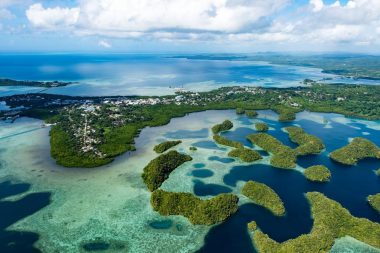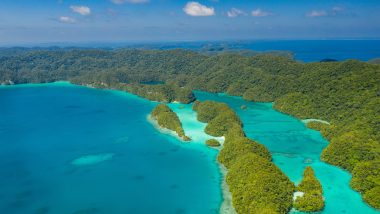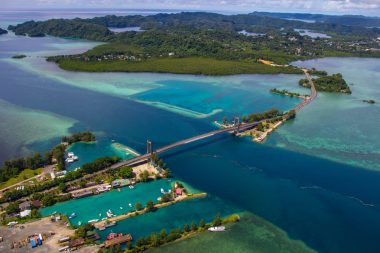White palm-fringed beaches, crystal clear waters with immense biodiversity, impressive limestone cliffs, mild tropical climate: this is Palau. The small state in Micronesia consists of three hundred islands, of which only eleven are inhabited.
Palau: a picturesque island world

In the immediate vicinity of the island state of Micronesia lies the magical Palau with its closely spaced Pacific islands. Not only romantics find all the colors there in the warm, bright sunshine simply a little stronger than in the rest of the world. Rich greens and deep blues help visitors feel like they’re in paradise. Guests visit thundering waterfalls, paddle a kayak through a unique world of shapes and colours or snorkel through the colourful dream landscape under water – because there are numerous sights of Palau: blue underwater caves, strictly vertical shore edges, old shipwrecks and a powerful explosion of colour from corals and fish. In Palau’s waters there are well over 1500 species of fish, 700 species of anemones and corals, including a lake filled with jellyfish or giant clams, each weighing over 250 kilos.
Sightseeing in the water around the islands does not require any particular depth: With so-called drift snorkeling, you can literally enjoy the fantastic nature floating in the gently flowing water – especially the unique coral diversity.
Built on coral reefs
Palau’s paradisiacal island world is about a four-hour flight from Tokyo, Seoul or Taipei. This makes it the most obvious destination in Micronesia. In addition, the small republic offers the richest flora and fauna among the approximately 2000 tropical islands and atolls of Micronesia. There are unique endemic species such as the Palau fantail, the fruit bat or the Palau owl. The islands were formed from a coral reef that was once lifted out of the ocean by continental movements. That’s why they are made of coral limestone, and the islands are usually only a few meters above sea level.
The island state on a coral bottom includes the Chelbacheb Islands and Koror, Micronesia’s second largest island of Babeldao, the rather small Anadur, the breathtakingly beautiful island of Peleliu with its remarkably tragic history, as well as some coral atolls and the southwest islands.
Palau’s most famous islands
-
The island of Babeldaob
The island of Babeldaob is Palau’s main island. On it lies the state of Melekeok in the east with its capital Ngerulmud and with the central administrative seat of Palau, which is also called Melekeok. In addition to a few government and administrative buildings, it consists of two supermarkets on a hill. Of interest is Palau’s oldest megalithic site with the Badrulchau stone monoliths from the time of origin of the island world around 150 AD.
The Ngardmau waterfall conjures up a real adventure pool feeling in the jungle – simply total bathing fun. By the way, the famous oceanographer Jacques Cousteau once stated that the steep walls of Palau are among the most impressive he has ever seen.
-
The Chelbacheb Islands

Chelbacheb, Image: Tomacrosse / shutterstock These are 200 limestone islands hollowed out by wind and weather. They are also called rock islands and are considered special beauties. In a sweeping lagoon, they lie well protected from the roaring ocean and covered with jungle like green mushrooms in the sunshine. The Chelbacheb Islands are considered a unique phenomenon of nature and the domicile of a diverse underwater life. For visitors, the magnificent beauty really comes into its own by kayak, in a boat or on a sightseeing flight.
-
The island of Peleliu
Here there is the beautiful, casual life. Therefore, it is hard to imagine that there had been hard, bloody battles between the Americans and the Japanese here during the Second World War. The beach is called Bloody Beach and is just as reminiscent of it as the numerous wrecks of planes and ships from that time. 1000 Man Cave is the name of the cave labyrinth near the village of Klouklubed, which was created by the Japanese at that time. A thousand soldiers had hidden in it. To this day, thousands and thousands of bullet casings are lying here, reporting on the fierce fighting. Thank God things are wonderfully relaxed on the beautiful island today.
-
The island of Eil Malk
The island of Eil Malk is uninhabited and there are a number of saltwater lakes here. The most famous is Ongeim’l Tketau, the Jellyfish Lake. Visitors to the island can swim there with the jellyfish or, to put it better, take a dip in the large crowd of medusae of Palau. When they float pulsating, almost transparent and fragile in the azure blue water, a meditative, magical spectacle opens up, at least for romantic minds. The jellyfish are always peaceful: in the absence of natural enemies, they have long since lost their poisonous tentacles.
-
The islands of Malakal and Koror

View of Koror, Image: Novena Assen / shutterstock Koror and Malakal are connected by a land bridge. Here you will find beautiful sandy beaches under palm groves. Boat tours to the island of Tobi with its only 20 inhabitants and a visit to the Palau Pacific Resort, surrounded by the jungle, are recommended. On Koror, the Nanyo Shrine commemorates the Japanese occupation during World War II. If you want to learn much more about the traditional life of the inhabitants of Palau, visit the Ngarachamayong Cultural Center on the spot.
Speaking of traditions: The cuisine of the islanders is remarkable. Pichi-Pichi, a typical Palau delicacy made from coconut and cassava, is extremely popular.
The island paradise of Palau
Magnificent landscapes, crystal clear waters, white beaches under palm trees, friendly islanders and great fun for the whole family: all this makes Palau the best destination for those looking for tropical paradise.


